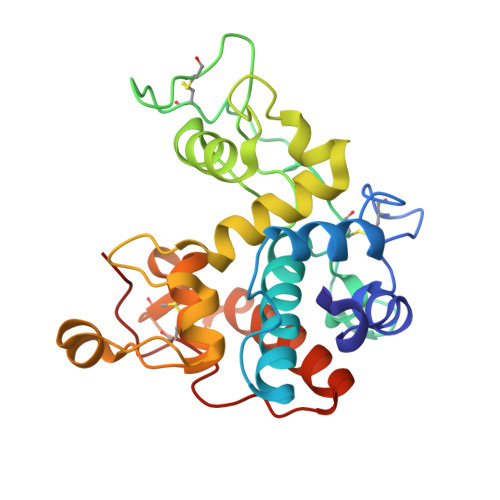Structural Analysis and Construction of a Thermostable Antifungal Chitinase.
Kozome, D., Uechi, K., Taira, T., Fukada, H., Kubota, T., Ishikawa, K.(2022) Appl Environ Microbiol 88: e0065222-e0065222
- PubMed: 35652665
- DOI: https://doi.org/10.1128/aem.00652-22
- Primary Citation of Related Structures:
7V91, 7V92 - PubMed Abstract:
Chitin is a biopolymer of N -acetyl-d-glucosamine with β-1,4-bond and is the main component of arthropod exoskeletons and the cell walls of many fungi. Chitinase (EC 3.2.1.14) is an enzyme that hydrolyzes the β-1,4-bond in chitin and degrades chitin into oligomers. It has been found in a wide range of organisms. Chitinase from Gazyumaru ( Ficus microcarpa ) latex exhibits antifungal activity by degrading chitin in the cell wall of fungi and is expected to be used in medical and agricultural fields. However, the enzyme's thermostability is an important factor; chitinase is not thermostable enough to maintain its activity under the actual application conditions. In addition to the fact that thermostable chitinases exhibiting antifungal activity can be used under various conditions, they have some advantages for the production process and long-term preservation, which are highly demanded in industrial use. We solved the crystal structure of chitinase to explore the target sites to improve its thermostability. We rationally introduced proline residues, a disulfide bond, and salt bridges in the chitinase using protein-engineering methods based on the crystal structure and sequence alignment among other chitinases. As a result, we successfully constructed the thermostable mutant chitinases rationally with high antifungal and specific activities. The results provide a useful strategy to enhance the thermostability of this enzyme family. IMPORTANCE We solved the crystal structure of the chitinase from Gazyumaru ( Ficus microcarpa ) latex exhibiting antifungal activity. Furthermore, we demonstrated that the thermostable mutant enzyme with a melting temperature ( T m ) 6.9°C higher than wild type (WT) and a half-life at 60°C that is 15 times longer than WT was constructed through 10 amino acid substitutions, including 5 proline residues substitutions, making disulfide bonding, and building a salt bridge network in the enzyme. These mutations do not affect its high antifungal activity and chitinase activity, and the principle for the construction of the thermostable chitinase was well explained by its crystal structure. Our results provide a useful strategy to enhance the thermostability of this enzyme family and to use the thermostable mutant as a seed for antifungal agents for practical use.
Organizational Affiliation:
Department of Bioscience and Biotechnology, University of the Ryukyusgrid.267625.2, Senbaru, Nishihara, Okinawa, Japan.














